Advanced Metering Infrastructure—Towards a Reliable Network
Abstract
:1. Introduction
2. Reliability and Smart Grid
- Integrated actions of all the EPS users;
- Monitoring of the EPS and a fast response to an unpredicted event;
- Online diagnostics and reconfiguration;
- Constant pressure towards lowering the cost of energy generated mainly at DES;
- Promoting effective consumption.
3. Advanced Metering Infrastructure (AMI) as a Factor Increasing the Reliability of the LV Grid
4. Analysis of the Identification of Events by Means of AMI/SCADA/OMS Case Study
4.1. Registration of Events in the Analyzed Network Based on Data from Smart Meters (Balancing/Customer)
- The balancing meters (BMs) installed in the MV/LV transformer station had wide capabilities of making measurements and recording events, such as voltage drops, voltage increases or power interruptions in individual phases. The algorithm of the procedure for determining the actual interruption times that occurred in the power grid located in the Area_id based on the events recorded by the PoC_id customer meters and the BM_id balancing meters required a consistent data structure and non-ambiguously defined relations;
- An important issue was the connection of events recorded in the BM_id balancing meters with events from PoC_id meters. It was a necessary condition for the correct determination of SAIDI and SAIFI values for particular levels of their granulation, i.e., for the level of PoS consumer meters, BM balancing meters, NS network lines, Tr_MV/LV transformer stations or the entire area. It should be noted that the balancing meters (BM) installed in the MV/LV transformer station usually have different event registration options as compared to PoC customers’ meters.
4.2. Correlation of Events from the AMI System with Events Recorded in the Systems of the Distribution Network Operator (e.g., SCADA/OMS)
- Another important issue is the unification (standardization) of the database structures located in the Central Database System with the event logs of specific dispatch offices, carried out within the Outage Management System (OMS). Attention should be paid to the necessity to introduce a uniform event dictionary for the whole area or system;
- It cannot be ignored that the OMS records events differently from the AMI system. The events recorded in AMI meters are consistent with the parameterization of the meters (which can be changed by the AMI system operator within the functionality of the meters themselves during their exploitation). On the other hand, OMS obtains information about events automatically through various teletechnical devices, from power protection automatics or circuit breakers. Some of the system events are the scheduled board manipulations of the operator. The events recorded in the OMS provide information whether the interruption that occurred was a scheduled interruption or an unscheduled one. OMS also provides information about the cause of the interruption;
- Moreover, the AMI system may have a different resolution of event recording, e.g., it may not record micro-interruptions. Therefore, the number of events recorded respectively by customer meters in PoC and BM balancing meters installed in MV/LV transformer stations may be different from OMS. The largest amount of information about events is registered at the consumer meters;
- The assignment of a given PoC to the network track and the MV/LV transformer provides information that cannot be obtained from the balancing meter;
- It is suggested that each elementary event is a separate item in the event log and is uniquely identified by the “id” of the objects involved in the event. A fragment of the event register for one balancing meter is presented in Table 1;
4.3. Calculation of SAIDI / SAIFI Indicators Broken down into for Particular Consumers, Network Tracks, Transformer Stations
- During the procedure of determining SAIDI / SAIFI, it is necessary to correlate the times of the events registered by balancing meters with the times of events registered by customers’ meters assigned to a given network track, since their coincidence in time is significant for the analysis;
- In order to correctly calculate reliability indices, it is key to take into account the replacements of balancing and customer’s meters and changes in the network structure. Modern fault location, isolation, and self-restoration systems are usually linked to a Geographic Information System (GIS), which is capable of locating faults with high precision and identifying objects affected by them. In the AMI system, it is the customers’ meters and balancing meters that have specific physical attributes, such as geographical position, address, name, recorded events and, of course, measurement data. Thus, PoC and BM link the actual measurement system and its parameters with the measurement site. Thanks to this, each event registered by PoC and/or BM, which is saved in the database environment, enables quick correlation analysis of events, and, consequently, the identification and location of events;
- The use of modern database technologies that process data by means of a multidimensional database—Online Analytical Processing ensures a fast response to failures in the power grid. Figure 2 shows an example of using data from various systems: AMI, SCADA, OMS, GIS and others, for the ongoing monitoring and management of events as well as for ongoing data analysis with respect to the reliability and efficiency of the power grid.
5. Analysis and Presentation of Reliability of a Distribution Grid on the Basis of Data Obtained from the System AMI in a Friendly Way for DSO Employees
6. Selected AMI Projects Implemented by DSOs in Poland
7. Conclusions
- AMI is the basic element of Smart Grid, enabling the transmission of transparent information about events occurring inside the LV grid and a key component of the system SCADA_LV, which is a tool for the visualization of events on the LV grid schema;
- AMI provides the most reliable data for the precise location of disturbances in the grid, and also for determining reliability indices for particular consumers, network tracks, transformer stations etc.;
- AMI offers the following advantages for increasing reliability: identification and location of faults; automatic sending of a message about a breakdown; lower cost of restoring the energy supply; tracing transient states; knowledge on faults and better consumer satisfaction as well as obtaining information on all anomalous events in the grid, including theft, and effective control;
- Using the presented methodology we can obtain the values of the SAIDI and SAIFI. Thanks to automated alerts from the AMI we get information on the occurrence of a failure sooner, which will allow the DSO more efficient reduction of power outages.
- The current challenge for the AMI, apart from identifying and locating faults in the LV network during disturbances, is also to supervise the quality of energy supplied to a customer during its normal operation. It is the challenge of particular importance in the areas of networks with high saturation of distributed generation in electricity storage and charging stations for electric cars (e.g., voltage level regulation, network switching);
- It is advisable to carry out further research so that the AMI would provide fuller and more reliable information that can be used it to obtain multifaceted knowledge about the network;
- It is advisable to present the calculated values of the AIDI and SAIFI indicators in a user-friendly manner. It is suggested to visualize the results of the reliability calculation on the diagram of a LV distribution network together with the geographic map as the background;
- IIoT solutions based on a combination of devices, including smart meters and clouds, appear to be especially promising for future projects conducted by the DSO;
- The added value of the IIoT solutions lies in the possibility of exploiting available data for fulfilling the DSM and DR tasks.
Author Contributions
Funding
Conflicts of Interest
Abbreviations
| ADMS | Advanced Distribution Management System |
| AMI | Advanced Metering Infrastructure |
| BM | balancing meter |
| DES | Distributed Energy Sources |
| DR | Demand Response |
| DSM | Demand-Side Management |
| DSO | Distribution System Operator |
| EPS | Electricity Power System |
| GIS | Geographic Information System |
| HAN | Home Area Network |
| IIoT | Industrial Internet of Things |
| KDE | Kernel Density Estimation |
| LV | Low Voltage |
| MDM | Meter Data Management |
| MV | Medium Voltage |
| OMS | Outage Management System |
| PoC | Points of Consumption |
| SAIDI | System Average Interruption Duration Index |
| SAIDI_p | SAIDI for scheduled interruptions |
| SAIDI_np | SAIDI for for unscheduled interruptions |
| SAIFI | System Average Interruption Frequency Index |
| SAIFI_p | SAIFI for scheduled interruptions |
| SAIFI_np | SAIFI for unscheduled interruptions |
| SCADA | Supervisory Control and Data Acquisition |
| SG | Smart Grid |
| SM | Smart Metering |
| VPP | Virtual Power Plants |
References
- Minister of Economy Order the Matter of Detailed Operation of the Power System, 4th May 2007, § 40–§ 41. (In Polish).
- Short, T.A. Distribution Reliability and Power Quality; CRC Press: Boca Raton, FL, USA, 2018. [Google Scholar]
- Amin, S.M.; Wollenberg, B.F. Toward a smart grid: Power delivery for the 21st century. IEEE Power Energy Mag. 2005, 3, 34–41. [Google Scholar] [CrossRef]
- Jasiński, M.; Sikorski, T.; Kaczorowska, D.; Rezmer, J.; Suresh, V.; Leonowicz, Z.; Kostyla, P.; Szymańda, J.; Janik, P. A Case Study on Power Quality in a Virtual Power Plant: Long Term Assessment and Global Index Application. Energies 2020, 13, 6578. [Google Scholar] [CrossRef]
- Le, D.P.; Bui, D.M.; Ngo, C.C.; Le, A.M.T. FLISR Approach for Smart Distribution Networks Using E-Terra Software—A Case Study. Energies 2018, 11, 3333. [Google Scholar] [CrossRef] [Green Version]
- Prado, G.; Sidney, J. The Power of Big Data and Data Analytics for AMI Data: A Case Study. Sensors 2020, 20, 3289. [Google Scholar] [CrossRef]
- Moslehi, K.; Kumar, R. Smart Grid-a reliability perspective. IEEE Smart Grid 2010, 1, 57–64. [Google Scholar] [CrossRef]
- Kornatka, M. Analysis of the Exploitation Failure Rate in Polish MV Networks. Eksploat. Niezawodn. Maint. Reliab. 2018, 20, 413–419. [Google Scholar] [CrossRef]
- Tomczykowski, J. Power grids of the five largest operators. Electricity 2015, 5, 23–25. (In Polish) [Google Scholar]
- Polish Power Transmission and Distribution Association. Distribution and Transmission of Electricity Report. Poznań. 2021. Available online: http://www.raport.ptpiree.pl (accessed on 20 August 2021). (In Polish).
- Gupta, P.; Ramesh, A.; Satvik, D.; Nagasundari, S.; HoLVavalli, P.B. Simulation of SCADA System for Advanced Metering Infrastructure in Smart Grid. In Proceedings of the 2020 International Conference on Smart Electronics and Communication (ICOSEC), Tamilnadu, India, 10–12 September 2020; pp. 1071–1077. [Google Scholar] [CrossRef]
- Martínez, R.; Martínez, R.; Cubillos, C.; Vargas, H.; Baeza, J.M. Self-healing of electric distribution networks: A review. In Proceedings of the 7th International Conference on Computers Communication and Control (ICCCC), Beijing, China, 16–18 August 2018. [Google Scholar] [CrossRef]
- Yang, L.; Xiao, F.; Chen, H.; Lai, Y.; Chollot, Y. The Experiences of Decentralized Self-Healing Grid. In Proceedings of the 2019 IEEE 8th International Conference on Advanced Power System Automation and Protection (APAP), Xi’an China, 21–24 October 2019; pp. 1864–1867. [Google Scholar] [CrossRef]
- Ndawula, M.B.; Djokic, S.Z.; Hernando-Gil, I. Reliability Enhancement in Power Networks under Uncertainty from Distributed Energy Resources. Energies 2019, 12, 531. [Google Scholar] [CrossRef] [Green Version]
- Palensky, S.; Dietrich, D. Demand Side Management: Demand Response, Intelligent Energy Systems, Smart Loads. IEEE Ind. Inf. 2011, 3, 381–388. [Google Scholar] [CrossRef] [Green Version]
- DMS Jabir, H.J.; Teh, J.; Ishak, D.; Abunima, H. Impacts of Demand-Side Management on Electrical Power Systems: A Review. Energies 2018, 11, 1050. [Google Scholar] [CrossRef] [Green Version]
- Improving Reliability and Efficiency. Available online: https://www.itron.com/-/media/resources/case-studies/comedcasestudy.pdf (accessed on 20 August 2021).
- EnerNOC Awarded Demand Response Contract with ARENA Enel X. Available online: https://www.enelx.com/n-a/en/press-releases/enernoc-awarded-50-megawatt-demand-response-contract-in-australia (accessed on 20 August 2021).
- Gaggero, G.B.; Marchese, M.; Moheddine, A.; Patrone, F. A Possible Smart Metering System Evolution for Rural and Remote Areas Employing Unmanned Aerial Vehicles and Internet of Things in Smart Grids. Sensors 2021, 21, 1627. [Google Scholar] [CrossRef]
- Black, J.; Hoffman, A.; Hong, T.; Roberts, J.; Wang, P. Weather Data for Energy Analytics: From Modeling Outages and Reliability Indices to Simulating Distributed Photovoltaic Fleets. IEEE Power Energy Mag. 2018, 16, 43–53. [Google Scholar] [CrossRef]
- Khalifeeh, R.; Alrashidi, H.; Sellami, N.; Mallick, T.; Issa, W. State-of-the-Art Review on the Energy Performance of Semi-Transparent Building Integrated Photovoltaic across a Range of Different Climatic and Environmental Conditions. Energies 2021, 14, 3412. [Google Scholar] [CrossRef]
- Pelle, M.; Lucchi, E.; Maturi, L.; Astigarraga, A.; Causone, F. Coloured BIPV Technologies: Methodological and Experimental Assessment for Architecturally Sensitive Areas. Energies 2020, 13, 4506. [Google Scholar] [CrossRef]
- López-Prado, J.L.; Vélez, J.I.; Garcia-Llinás, G.A. Reliability Evaluation in Distribution Networks with Microgrids: Review and Classification of the Literature. Energies 2020, 13, 6189. [Google Scholar] [CrossRef]
- Reinders, A. Perceived and Reported Reliability of the Electricity Supply at Three Urban Locations in Indonesia. Energies 2018, 11, 140. [Google Scholar] [CrossRef] [Green Version]
- Kornatka, M.; Gawlak, A.; Dudek, G. Determination of Reliability Indicators of the Distribution Network Based on Data from AMI. In E3S Web of Conferences; EDP Sciences: Ulis, France, 2019; Volume 84, p. 02004. [Google Scholar] [CrossRef] [Green Version]
- AMI and Reliability: Fewer Outages, Faster Restorations, Improved Communications. Available online: https://www.landisgyr.com/webfoowp-content/uploads/2020/07/ami-reliability.pdf (accessed on 20 August 2021).
- Yan, H.; Nick, J.; Jianzhong, W. Smart Metering for Outage Management of Electric Power Distribution Networks. Enrgy Proced 2016, 103, 159–164. [Google Scholar] [CrossRef]
- Khalil, R.A.; Saeed, N.; Masood, M.; Fard, Y.M.; Alouini, M.S.; Al-Naffouri, T.Y. Deep Learning in the Industrial Internet of Things: Potentials. Challenges, and Emerging Applications. IEEE Internet Things 2021, 8, 11016–11040. [Google Scholar] [CrossRef]
- Talari, S.; Shafie-khah, M.; Siano, P.; Loia, V.; Tommasetti, A.; Catalão, J.P.S. A Review of Smart Cities Based on the Internet of Things Concept. Energies 2017, 10, 421. [Google Scholar] [CrossRef] [Green Version]
- Parvez, I.; Sarwat, A.I.; Wei, L.; Sundararajan, A. Securing Metering Infrastructure of Smart Grid: A Machine Learning and Localization Based Key Management Approach. Energies 2016, 9, 691. [Google Scholar] [CrossRef]
- Bonnefoi, R.; Moy, C.; Palicot, J. Advanced metering infrastructure backhaul reliability improvement with cognitive radio. In Proceedings of the 7th IEEE International Conference on Smart Grid Communications, Sydney, Australia, 6–9 November 2016; pp. 230–236. [Google Scholar] [CrossRef] [Green Version]
- Mahapatra, C.; Moharana, A.K.; Leung, V.C.M. Energy Management in Smart Cities Based on Internet of Things: Peak Demand Reduction and Energy Savings. Sensors 2017, 17, 2812. [Google Scholar] [CrossRef] [PubMed] [Green Version]
- Meliopoulos, A.; Polymeneas, E.; Tan, Z.; Huang, R.; Zhao, D. Advanced Distribution Management System. IEEE Trans. Smart Grid 2013, 4, 2109–2117. [Google Scholar] [CrossRef]
- Dubey, A.; Bose, A.; Liu, M.; Ochoa, L. Paving the Way for Advanced Distribution Management Systems Applications: Making the Most of Models and Data. IEEE Power Energy Mag. 2020, 18, 63–75. [Google Scholar] [CrossRef]
- Silverman, B.W. Density Estimation for Statistics, Data Analysis; Chapman and Hall: London, UK, 1986. [Google Scholar]
- R Evelopment Core Team© R: A Language and Environment for Statistical Computing. Available online: https://cran.r-project.org/ (accessed on 20 August 2021).
- Dynamic Power Supply Path Determination of the Point of Consumption (PoC) in the Enea Operator Grid. Available online: https://www.operator.enea.pl/operator/o-enei-operator/publikacje-merytoryczne/dynamic-power-supply-path-determination-of-the-point-of-consumption-eng.pdf (accessed on 20 August 2021).
- AMIplus for You. Available online: https://amiplus.tauron-dystrybucja.pl/amiplus-for-you (accessed on 20 August 2021).
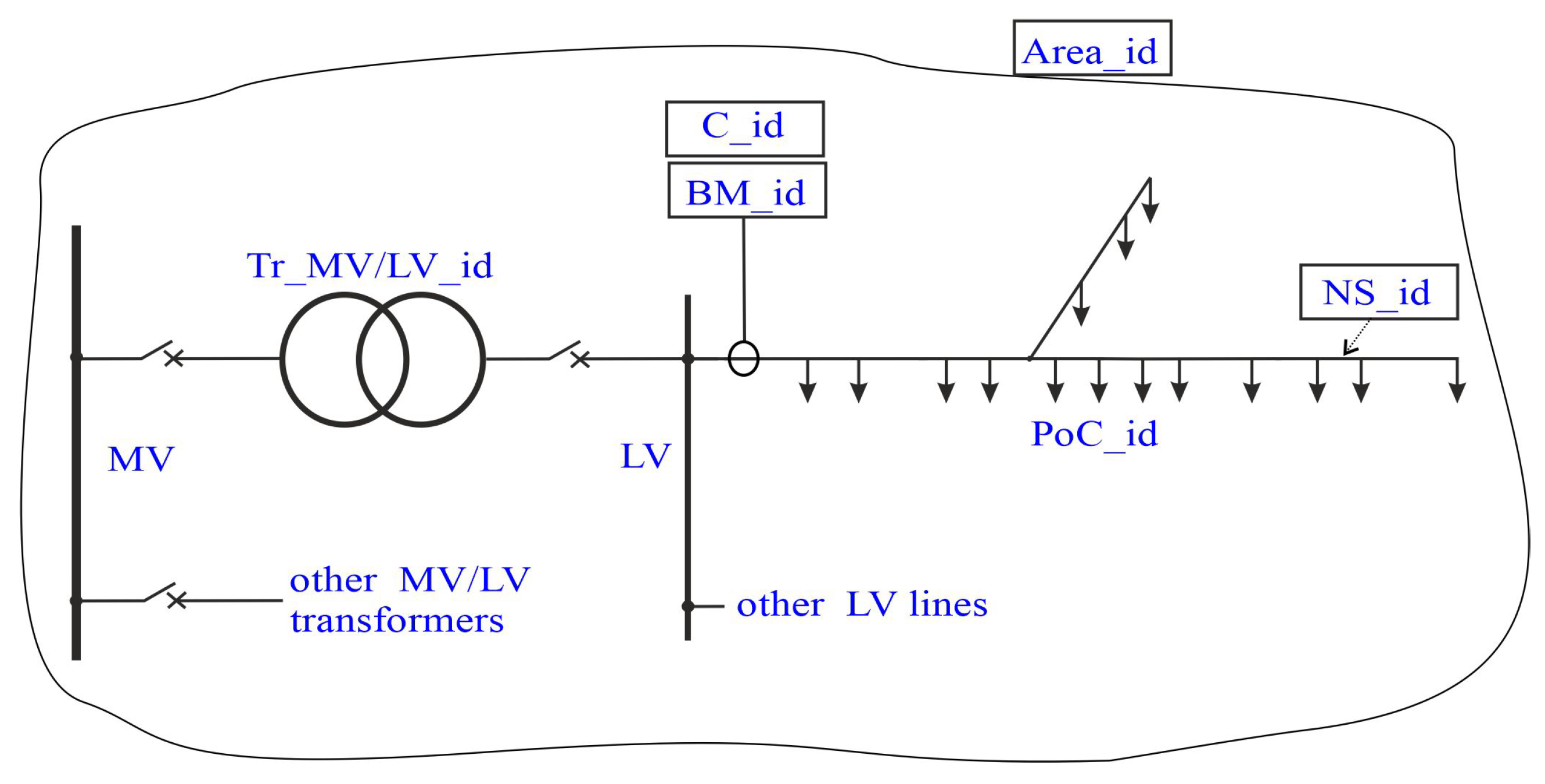
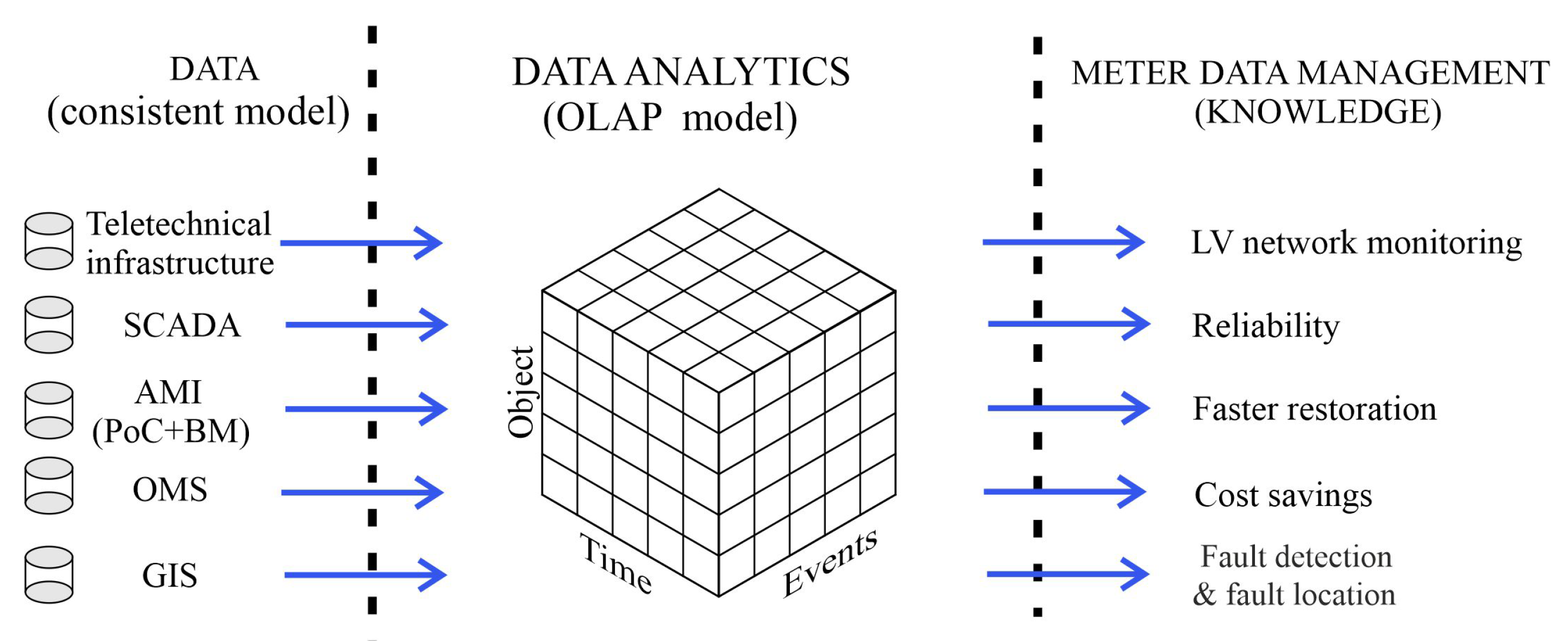
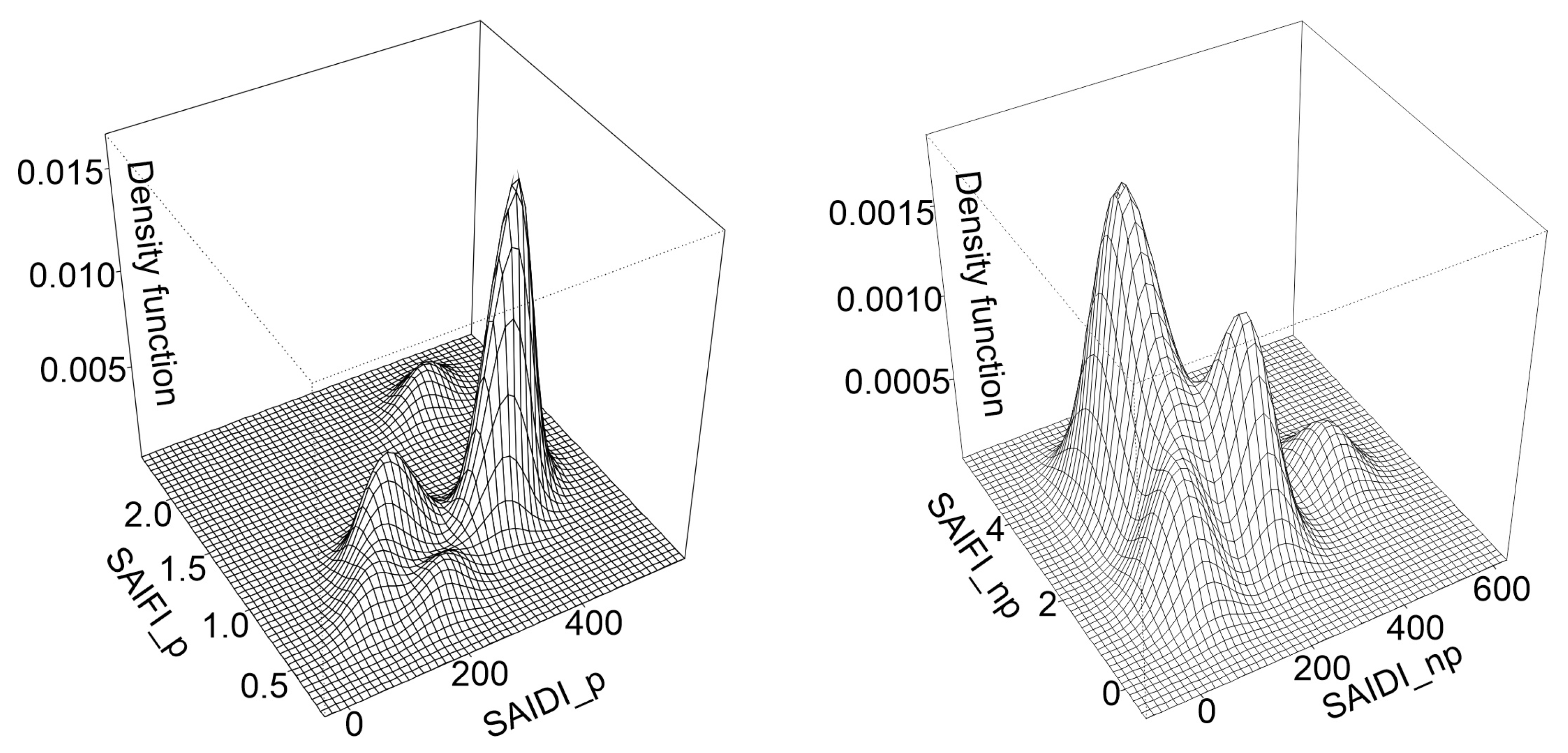
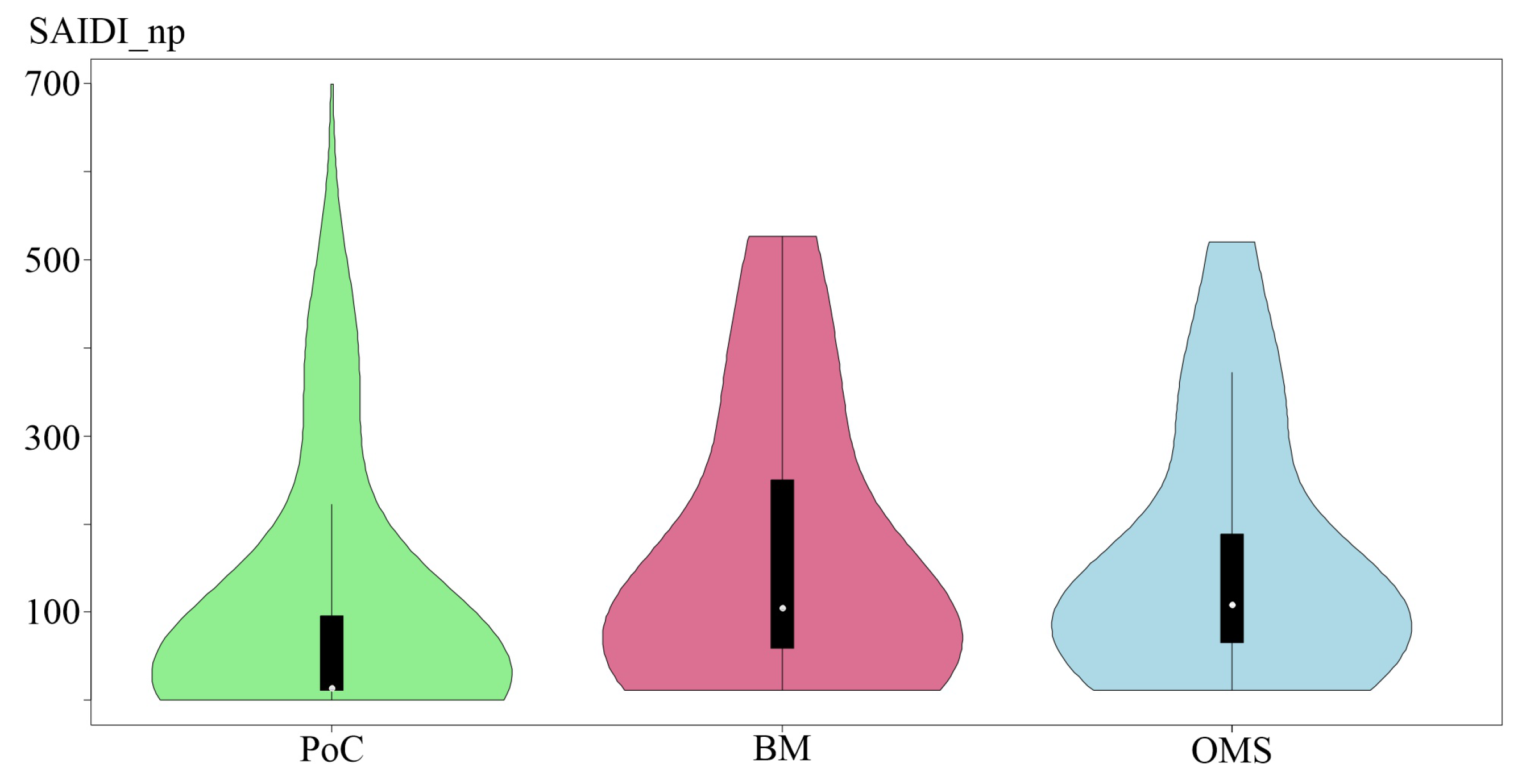
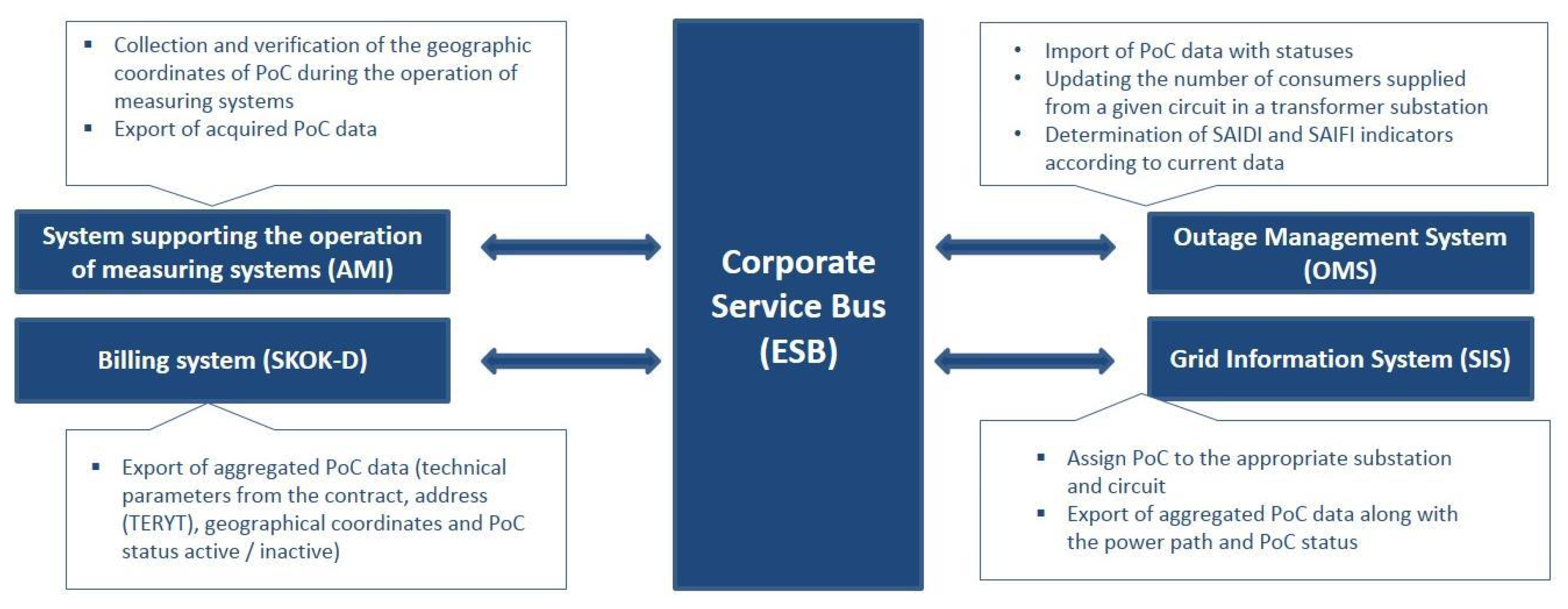

| BM_id | SED | SET | EED | EET | N_CUSTOMERS | CAUSE_id |
|---|---|---|---|---|---|---|
| 1234567 | 2019-02-10 | 12:15:50 | 2019-02-10 | 12:28:01 | 45 | n12 |
| 1234567 | 2019-02-13 | 15:59:03 | 2019-02-13 | 16:03:27 | 45 | p30 |
| 1234567 | 2019-02-13 | 16:19:06 | 2019-02-13 | 17:06:20 | 45 | p30 |
| 1234567 | 2019-02-13 | 17:07:18 | 2019-02-13 | 17:18:07 | 45 | p10 |
| 1234567 | 2019-02-19 | 20:16:07 | 2019-02-19 | 20:18:07 | 45 | n12 |
Publisher’s Note: MDPI stays neutral with regard to jurisdictional claims in published maps and institutional affiliations. |
© 2021 by the authors. Licensee MDPI, Basel, Switzerland. This article is an open access article distributed under the terms and conditions of the Creative Commons Attribution (CC BY) license (https://creativecommons.org/licenses/by/4.0/).
Share and Cite
Kornatka, M.; Popławski, T. Advanced Metering Infrastructure—Towards a Reliable Network. Energies 2021, 14, 5986. https://doi.org/10.3390/en14185986
Kornatka M, Popławski T. Advanced Metering Infrastructure—Towards a Reliable Network. Energies. 2021; 14(18):5986. https://doi.org/10.3390/en14185986
Chicago/Turabian StyleKornatka, Mirosław, and Tomasz Popławski. 2021. "Advanced Metering Infrastructure—Towards a Reliable Network" Energies 14, no. 18: 5986. https://doi.org/10.3390/en14185986
APA StyleKornatka, M., & Popławski, T. (2021). Advanced Metering Infrastructure—Towards a Reliable Network. Energies, 14(18), 5986. https://doi.org/10.3390/en14185986







